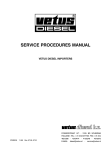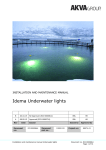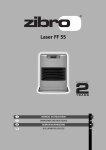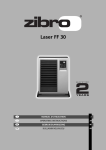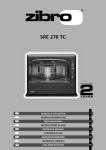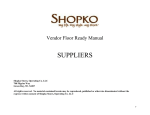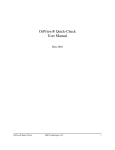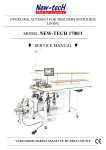Download Chapter 25 – Machinery Condition Monitoring 2015
Transcript
Chapter 25 – Machinery Condition Monitoring 2015 Unless otherwise specified, these Rules apply to ships for which the date of contract for construction as defined in IACS PR No.29 is on or after 01st January 2015. New rules or amendments entering into force after the date of contract for construction are to be applied if required by those rules. See Rule Change Notices on TL website for details. "General Terms and Conditions" of the respective latest edition will be applicable (see Rules for Classification and Surveys). If there is a difference between the rules in English and in Turkish, the rule in English is to be considered as valid. This publication is available in print and electronic pdf version. Once downloaded, this document will become UNCONTROLLED. Please check www.turkloydu.org for the amended and valid version. All rights are reserved by Türk Loydu, and content may not be reproduced, disseminated, published, or transferred in any form or by any means, except with the prior written permission of TL. TÜRK LOYDU Head Office Postane Mah. Tersaneler Cad. No:26 Tuzla 34944 İSTANBUL / TÜRKİYE Tel : (90-216) 581 37 00 Fax : (90-216) 581 38 00 E-mail : [email protected] http://www.turkloydu.org Regional Offices Ankara İzmir Adana Eskişehir Yolu Mustafa Kemal Mah. 2159. Sokak No : 6/4 Çankaya - ANKARA / TÜRKİYE Tel : (90-312) 219 56 34 Fax : (90-312) 219 68 25 E-mail : [email protected] Atatürk Cad. No :378 K.4 D.402 Kavalalılar Apt. 35220 Alsancak - İZMİR / TÜRKİYE Tel : (90-232) 464 29 88 Fax : (90-232) 464 87 51 E-mail : [email protected] Çınarlı Mah. Atatürk Cad. Aziz Naci İş Merkezi No:5 K.1 D.2 Seyhan - ADANA / TÜRKİYE Tel : (90- 322) 363 30 12 Fax : (90- 322) 363 30 19 E-mail Marmaris : [email protected] Atatürk Cad. 99 Sok. No:11 Kat:4 Daire 6 Tel : (90- 252) 412 46 55 Fax : (90- 252) 412 46 54 E-mail : [email protected] Marmaris - MUĞLA / TÜRKİYE Contents Machinery Condition Monitoring Page Section 1 - General A. General ...................................................................................................................................................... 1- 2 B. Definitions .................................................................................................................................................. 1- 2 C. Documents to be Submitted ....................................................................................................................... 1- 4 D. Survey Arrangement .................................................................................................................................. 1- 5 E. Planned Maintenance System ................................................................................................................... 1- 5 Section 2 - Requirements for the Design of Condition Monitoring Systems A. General Requirements ............................................................................................................................... 2- 2 B. Requirements for Installation ..................................................................................................................... 2- 2 C. Requirements for Software ........................................................................................................................ 2- 3 D. Steps of Acceptance .................................................................................................................................. 2- 3 Section 3 - Requirements for Operation A. Operating Personnel .................................................................................................................................. 3- 2 B. Measurements ........................................................................................................................................... 3- 2 C. Analysis ..................................................................................................................................................... 3- 2 D. Reporting .................................................................................................................................................... 3- 3 E. Documents available on Board ................................................................................................................... 3- 3 Section 4 - Surveys A. General ...................................................................................................................................................... 4- 2 B. Implementation Survey .............................................................................................................................. 4- 2 C. Final Approval ............................................................................................................................................ 4- 2 D. Annual Survey ........................................................................................................................................... 4- 2 E. Non-periodical Surveys .............................................................................................................................. 4- 2 Annex A - Examples for Application A. Scope ........................................................................................................................................................ A- 2 B. Cranktrain Bearings of Low-speed Diesel Engines ..................................................................................... A- 2 C. Centrifugal Pumps ..................................................................................................................................... A- 2 D. Accumulator Battery .................................................................................................................................. A- 4 Annex B - Standards for Lubricating Oil Analysis A. Test Methods .............................................................................................................................................. B- 2 Section 1 – General 1-1 SECTION 1 GENERAL Page A. GENERAL ......................................................................................................................................................... 1- 2 1. Scope 2. Purpose 3. Structure of Condition Monitoring Systems 4. Equivalence B. DEFINITIONS .................................................................................................................................................... 1- 2 1. Baseline Data 2. Condition Based Maintenance 3. Condition Based Survey 4. Condition Monitoring 5. Condition Monitoring Equipment 6. Condition Monitoring System 7. Condition Monitoring Method 8. Machinery Component 9. Machinery System 10. Planned Maintenance System (PMS) 11. Reference Conditions 12. Reference Values 13. Trend Analysis C. DOCUMENTS TO BE SUBMITTED .................................................................................................................. 1- 4 1. General 2. Scope of Documentation D. SURVEY ARRANGEMENT ............................................................................................................................... 1- 5 E. PLANNED MAINTENANCE SYSTEM .............................................................................................................. 1- 5 TÜRK LOYDU - MACHINERY CONDITION MONITORING - 2015 Section 1 – General 1-2 A. A,B of producing relevant data trends from the values General collected 1. Scope 1.1 These and compare them with pre-defined acceptance criteria (e.g. limit curves). Guidelines for Machinery Condition Condition 2.3 Monitoring for a Machinery Monitoring apply to the machinery of ships, which are Component, or parts of it, will be accepted by TL, if it is classified by TL, and for which a Survey Arrangement capable CM has been concluded between the owner/operator of information for determining the actual condition of the the ship and TL. Machinery Component, or parts of it. 1.2 These Guidelines can be applied to new ships 2.4 of producing reliable and trustworthy The condition determination of a Machinery and to existing ships. For already existing ships, for Component or parts of it, achieved from a TL accepted which a Survey Arrangement CM will be requested, Condition special considerations concerning their actual wear and equivalent tear condition have to be undertaken. inspection, compare Section 4. 1.3 These Guidelines apply in addition to the TL 3. Monitoring to System, condition will be determination considered by direct Structure of Condition Monitoring Systems Rules for Classification and Construction. Condition Monitoring Systems are distinguished in three 1.4 The Guidelines set out TL's general categories: requirements regarding Condition Monitoring, which are the basis for the acceptance of Condition Monitoring − fixed installed systems − systems with portable measurement equipment − sampling systems, e.g. for oil sampling 4. Equivalence with respect to Condition Based Survey. 1.5 If a Condition Monitoring System is used in the frame of a monitoring and control system and/or a safety system, the respective TL Rules for monitoring and control systems and/or for safety systems shall be applied, see in particular Chapter 5 – Electrical Installation, Section 9, B. Condition Monitoring Systems deviating from these Guidelines in their type, equipment or some of their 1.6 For propeller shafts running within the stern tube in oil under special conditions the intervals between parts may be accepted, provided that they are found to be equivalent to the TL requirements. shaft withdrawals may be prolonged and the Class Notation CM-PS may be assigned, see Chapter 2 – Machinery, Section 5, C. B. 2. Purpose The following definitions are used in this Guideline. 2.1 The purpose of Condition Monitoring Systems is 1. Definitions Baseline Data to detect ongoing deterioration, especially wear and tear, of Machinery Components or parts of them. For this Baseline Data are generally obtained during operation purpose values of significant parameters are to be on board, where the performance of the component is collected with the aid of an adequate measurement considered to meet the initial condition. chain. The values shall be suitable to show an obvious trend of the monitored deterioration over a period of time. Baseline Data are measured or observed Reference Values defining the initial condition of a Machinery 2.2 Condition Monitoring Systems shall be capable Component or parts of it, during operation under Reference Conditions. TÜRK LOYDU - MACHINERY CONDITION MONITORING - 2015 Section 1 – General B 2. Condition Based Maintenance 1-3 7. Condition Monitoring Method Condition Based Maintenance is a form of preventive The maintenance which uses the information from a technique Condition Monitoring System as additional input to information about the condition of components or parts adjust the planned activities according to the actual of it. Examples are vibration monitoring, oil analysis, wear and tear condition of a Machinery Component. performance monitoring, thermography or motor current condition for Monitoring the Method collection describes and the evaluation of signature analysis. It is recommended to include the so-called Condition Based Maintenance actions into the Planned 8. Machinery Component Maintenance System. Machinery Components are units, such as diesel 3. engines, Condition Based Survey generators, pumps, compressors, fans. Machinery Components consist of machinery parts, A Condition Based Survey for Machinery Components such as bearings, rotors, etc. operating under Condition Monitoring is a survey where the TL Surveyor primarily checks the Condition 9. Machinery System Monitoring Reports defined in Section 3, D. If such reports are giving evidence to the Surveyor that the A Component or part of it, is in an acceptable running Components, providing condition, he may grant a waiver from dismantling of the operation the Component for direct inspection. refrigerating Machinery of System is a group specific ship's installation. of Machinery functions machinery Examples for and/or for the cargo Machinery Systems are fuel oil systems, cooling systems, 4. ventilation systems, etc. Condition Monitoring Condition Monitoring comprises actions collecting 10. Planned Maintenance System (PMS) detect failures or deterioration of machinery condition. PMS is Measurements or observations shall be carried out maintenance and overhaul activities of machinery and during operation under defined Reference Conditions. electrical regularly information about machinery condition to a computerized plant system components that organises according to manufacturers', Owners' and/or Classification Societies' Within the scope of these Guidelines a clear distinction requirements. is made between Condition Monitoring and monitoring intervals, maintenance instructions, lists of required for control or safety systems (see A.1.5). spare parts, measurement records and other relevant The system includes maintenance information. 5. Condition Monitoring Equipment For the requirement of such a system see Classification Condition Monitoring Equipment is any equipment used and Surveys, Section 3, A 4.5. to carry out Condition Monitoring measurements. 11. 6. Reference Conditions Condition Monitoring System Reference Conditions are operating and/or ambient Condition Monitoring System is a system used to detect conditions during recording of Condition Monitoring the condition of a component. It consists of Condition data, e.g. operating conditions of the monitored Monitoring Equipment, procedures, schedules as well component (e.g. speed, temperatures, pressures), as methods for data collection and analysis procedures operating conditions of surrounding systems, operating including trend estimation. conditions of the ship (e.g. speed, draft) and relevant ambient conditions (e.g. pressure, sea state, wind). TÜRK LOYDU - MACHINERY CONDITION MONITORING - 2015 temperature, barometric Section 1 – General 1-4 B,C Reference Conditions are described by respective 2.1 reference parameters. covered Reference Conditions should be reproducible during A list and description of the Machinery Components to normal operation. be covered by Condition Monitoring shall be provided. 12. 2.2 Reference Values Listing of Machinery Components to be Condition Monitoring System Reference values are values of the measurement Descriptions of the complete Condition Monitoring parameters or descriptors that define the condition of a System to be used specifying the following items: Machinery Component or part of it, which is in an acceptable running condition. With respect to Trend − overview of the system − functional description, including user manual, Analysis, Reference Values are also referred to as Baseline Data. parameter definition, data collection method, Reference Values are valid only for predefined data handling, data analysis method Reference Conditions. They can be obtained by measurement or observation of a component or part of − it, which is proven to be free of failure or by rules and local arrangement including location and orientation of measuring points standards. − 13. sampling method and sampling points, if applicable Trend Analysis A Trend Analysis presents time histories of measurement − wiring diagram, if applicable − power supply scheme, if applicable − parts parameters or descriptors to evaluate the extent and progress of deterioration and the trends for the future. C. list including sensors (model, type, manufacturer, technical data sheet, attachment Documents to be submitted method) and data collection instruments (model, 1. type, manufacturer, technical data sheet) General The required drawings, documents, calculations and − supporting documentation are to be submitted in TL approval for the Condition Monitoring System (see Section 2, D.), if already existing Turkish or English language. This shall be done at a sufficiently early date before the Condition Monitoring − TL approval, if already existing, for installation of System is installed on the ship. For prototype systems the measuring device (e.g. sensors, cables etc.) special agreements may be considered. on the respective Machinery Component based on 2. If the TL approval for a Condition Monitoring System is requested with the aim to the agreement of the Component manufacturer Scope of documentation conclude a 2.3 Details about Machinery Components Survey Arrangement CM (see D.) the following documentation For each Machinery Component covered by Condition has to be submitted to TL Head Office for approval. Monitoring the following items shall be specified: − actual condition of each Component, information about running hours, etc. TÜRK LOYDU - MACHINERY CONDITION MONITORING - 2015 e.g. Section 1 – General C,D,E − 1-5 procedure of Baseline Data collection, including Monitoring System on a ship under construction or at specification of Reference Condition(s) sea are also subject to approval by TL. Documents are to be submitted in due time before conversion. − procedure and schedule for collection of actual operating data − D. Survey Arrangement 1. Where Machinery Components subject to Class procedure and schedule for data analysis (including applied acceptance criteria for parameters) and reporting the results. Surveys are covered by Condition Monitoring, a Survey Arrangement − procedure and schedule for calibration and functional tests of Condition CM can be agreed between the owner/operator of the ship and TL. Monitoring Equipment 2. The Survey Arrangement CM shall follow the relevant requirements defined in the following Sections. − agreement of Component manufacturer to the Condition Monitoring parameters, Condition Monitoring Method, Reference Values, etc. 3. Machinery Components covered by the Survey Arrangement CM will be listed in the Approval Certificate. 2.4 Further Documents TL reserves the right to demand other documents E. Planned Maintenance System where these submitted are not adequate to provide an evaluation of the system. The Condition Monitoring System shall be used in the framework of a computerized Planned Maintenance 2.5 Modifications/extensions of Machinery Components or Condition Monitoring Systems System (PMS). The elements of the PMS considering the Machinery Components or part of them covered by Condition Monitoring shall be approved by TL according Major modifications of the Machinery Components to the TL Rules Classification and Surveys, Section 3, A and/or the Condition Monitoring System which may 4.5. affect the functioning of the approved Condition TÜRK LOYDU - MACHINERY CONDITION MONITORING - 2015 Section 2 – Requirements for the Design of Condition Monitoring Systems 2-1 SECTION 2 REQUIREMENTS FOR THE DESIGN OF CONDITION MONITORING SYSTEMS Page A. GENERAL REQUIREMENTS............................................................................................................................ 2- 2 1. Ambient Conditions 2. Interference to Machinery Control B. REQUIREMENTS FOR INSTALLATION .......................................................................................................... 2- 2 1. General 2. Portable Systems 3 Fixed Installed Systems 4. Central Recording and Processing Computer C. REQUIREMENTS FOR SOFTWARE ................................................................................................................ 2- 3 1. Data Measurement 2. Data Analyses D. STEPS OF ACCEPTANCE ............................................................................................................................... 2- 3 1. Design Approval 2. Type Approval for Components of Condition Monitoring Systems 3. Case by Case Approval of a Condition Monitoring System 4. Type approval of Condition Monitoring Systems TÜRK LOYDU - MACHINERY CONDITION MONITORING - 2015 2-2 A. Section 2 – Requirements for the Design of Condition Monitoring Systems General Requirements A,B the Condition Monitoring System is still functioning reliably. 1. Ambient conditions 1.5 In principle, Machinery Components already in The Condition Monitoring System has to operate under service can only be included in a Condition Based the ambient conditions of ship machinery installations Maintenance scheme, if evidence is given that the as defined in the TL Rules Chapter 4 – Machinery, Components are in a condition close to their initial Section condition. In any case, an initial survey is mandatory. 1, C. The degree of protection of electric/electronic components against the ingress of foreign bodies and water according to TL Rules Chapter 1.6 5 – Electrical Installation, Section 1, K is to be process is assisted by an expert familiar with the considered. Condition Monitoring System and with the respective It is recommended that the implementation Machinery Component. 2. Interference to machinery control 2. Portable systems Data acquisition from machinery control and monitoring systems for Condition Monitoring purposes has to be Portable measurement devices are used for such free of reactive effects. systems. The position of the measurement points, and in case of B. Requirements for Installation directed values, the measurement direction, shall be marked permanently. The coupling of the sensor to the 1. General measurement point shall be designed in an adequate way to avoid any human influences. 1.1 Correct functioning and accuracy in measurement of all measurement devices shall be 3. Fixed installed systems calibration procedures. They have to be documented. 3.1 The measuring devices shall be fixed installed at Equipment for functional tests of the measurement the Machinery Components to be monitored. assured by individual functional tests and regular devices shall be available on board. 3.2 1.2 The manufacturer of a Machinery Component to be included in the Condition Monitoring System has to The cables for data transfer shall comply with the requirements of the TL Rules Chapter 5 – Electrical Installation, Section 12. give his agreement to the installation of the measuring device on the Component as well as to the Condition 3.3 Monitoring Method to be introduced for the Component. equipped with a directly connected central recording On the basis of this agreement TL can approve the and processing unit. above mentioned installation and the The Condition Monitoring System has to be Condition Monitoring Method. 3.4 Disturbed data collection shall be indicated and recorded in a log file. 1.3 All parts of the Condition Monitoring System have to be installed in a way to enable accessibility for 4. Central recording and processing computer 4.1 The provided central recording and processing survey, maintenance, repair and calibration. 1.4 If parts of Machinery Components or even computer shall be capable of running the necessary Components as a whole, which influence the design analysis programs. The storage capacity shall be and/or operation of the Condition Monitoring System, suitable to keep the data used for the Annual Condition have to be changed/renewed, it shall be ensured that Monitoring Reports (see Section 3, D.2) at minimum since the last Annual Survey. TÜRK LOYDU - MACHINERY CONDITION MONITORING - 2015 B,C,D 4.2 Section 2 – Requirements for the Design of Condition Monitoring Systems Computers in systems to be type approved shall meet the requirements defined in Chapter 5 – Electrical 2-3 shall enable a clear evaluation of the actual condition of the component or parts of it. Installation, Section 10. 2.2 4.3 Trend analysis The computer system has to be only accessible for authorized operating personnel, see Section 3, A. A trend analysis has to be established for the time development of the measurement values. For this the measurement values are to be presented over the C. Requirements for Software operation time considering the Reference Conditions. From this presentation it shall be possible to derive the The software for the central recording and processing consequences for necessary actions. computer shall meet the requirements defined in Chapter 5 – Electrical Installation, Section 10. In addition, the following requirements shall be fulfilled. D. 1. If an owner/operator of a ship requests a Survey Data measurement Steps of Acceptance Arrangement CM as defined in Section 1, D. the 1.1 Reference Values for the parameters to be monitored shall be accepted by the manufacturer of the monitored Machinery Component, the following steps of technical acceptance have to be executed: Condition Monitoring System provider and require approval by TL. 1. 1.2 The documentation as defined in Section 1, C. has to be The Reference Values shall be displayed together with the trend curves. Design approval submitted to TL Head Office and checked to achieve the design approval. 1.3 Reference parameters defining Reference Conditions and Condition Monitoring data shall be 2. measured within an adequate time window to ensure Monitoring Systems Type approval for components of Condition that the values belong to the same operating conditions. All essential components of a Condition Monitoring 1.4 The sampling rate of the data acquisition shall be System have to be type approved. For detailed adequate for the respective duty of the Condition requirements see TL Rules, Additional Rules and Monitoring method. Guidelines, Guidelines for the Performance of Type Approvals, and Chapter 5 – Electrical Installation, 1.5 The evaluation rate shall be adequate to ensure Section 10. detection of failures at the Machinery Components in time. 3. Case by case approval of a Condition Monitoring System 1.6 In fixed installed systems all data which define the Reference Conditions of the Machinery Component 3.1 shall be made available. System designed for a special, singular application on For an approval of a Condition Monitoring board of a ship the components of the Condition 2. Data analyses Monitoring System shall be type approved according to 2. 2.1 Monitoring and diagnosis 3.2 After installation of the complete fixed or portable The Condition Monitoring System used to evaluate a system on board of the ship, tests will be made in component's adequate presence of TL representatives considering the overall monitoring and diagnosis functions. These functions functioning during the sea trials and after an operating condition shall provide TÜRK LOYDU - MACHINERY CONDITION MONITORING - 2015 2-4 Section 2 – Requirements for the Design of Condition Monitoring Systems D time of successful operation – the length of which will be After successful testing, a Type Approval Certificate will defined according to scope and complexity of the be issued with the remark that a successful check of the system – the Condition Monitoring System is approved. application on board is still pending. 4. 4.2 Type approval of Condition Monitoring Systems If a system with a Type Approval Certificate according to 4.1 is installed on board of a ship, after the sea trials and after an operating time of successful 4.1 It is possible to get – on request – also type operation – the length of which will be defined according approval for a complete, fixed installed Condition to scope and complexity of the system – the Type Monitoring System. In this case the components shall Approval Certificate will get the remark that the be type approved according to 2. and the overall application on board has been successful. functioning of the system has to be proven by suitable tests. TÜRK LOYDU - MACHINERY CONDITION MONITORING - 2015 Section 3 – Requirements for Operation 3-1 SECTION 3 REQUIREMENTS FOR OPERATION Page A. OPERATING PERSONNEL .............................................................................................................................. 3- 2 B. MEASUREMENTS ............................................................................................................................................ 3- 2 1. Intervals 2. Baseline Data 3. Reference Conditions 4. Documentation of Results 5. Significant Failures and Defects C. ANALYSIS ......................................................................................................................................................... 3- 2 1. Documentation 2. Reference Values 3. Special Analysis Methods D. REPORTING...................................................................................................................................................... 3- 3 1. Immediate Reports 2. Annual Condition Monitoring Report E. DOCUMENTS AVAILABLE ON BOARD .......................................................................................................... 3- 3 TÜRK LOYDU - MACHINERY CONDITION MONITORING - 2015 Section 3 – Requirements for Operation 3-2 A. A,B,C Reference Conditions cannot be established at the time Operating Personnel of the measurements, the measured values shall be 1. The chief engineer shall be the responsible person on board in charge of the Condition Monitoring converted to Reference Conditions, applying suitable conversion algorithms. Systems. 4. 2. Documentation of results The operation of Condition Monitoring Systems is to be carried out only by assigned personnel. To facilitate the comparison of the actual measurement results with the Baseline Data, Baseline Data shall be 3. The qualification of the operating personnel has to be proven by adequate documents, compare Section displayed or noted together with the documented results. 4, B.2. 5. Significant failures and defects Such documents may relate to existing experience with Condition training Significant failures and defects of the Condition received/planned for the Condition Monitoring System Monitoring and/or suitable Monitoring System which cause that trends of the installed on the ship. measured data cannot be controlled, have to be repaired promptly. B. 1. Measurements C. Analysis 1. Documentation Intervals Measurements for Condition Monitoring purposes shall be taken at defined intervals. The length of the intervals Measurement results shall be documented in tables or depends on the individual monitoring task and has to be graphs. The trend of the measured data versus time has defined for each individual task and each component. to be documented and is in general the relevant information to judge the condition of the monitored 2. Baseline Data Machinery Component. 2.1 Baseline Data shall be taken at Reference 2. Reference Values measurements and shall be adjusted during the period of 2.1 Reference Values shall be presented together successful operation according to Section 2, D.3. and D.4. with the documented results. A comparison of the Conditions. The conditions have to be documented during measured values with the Reference Values provides Measurements of Baseline Data have to be carried out the basis for the assessment of the condition status. to the satisfaction of TL. 2.2 Reference Values may be reconsidered, taking For retrofit of a Condition Monitoring System, into account the operation experience with the individual special consideration has to be given regarding the machinery on board the ship. See also Section 2, C.1.1. 2.2 definition of the Reference Values of each component subject to Condition Monitoring. This has to be done on 3. Special analysis methods a case by case basis. The requirements for special analysis methods, like the 3. periodical analysis of liquids, will be defined case by Reference Conditions case depending on the application. Measurements for Condition Monitoring purposes shall be taken at Reference Conditions. The Reference Conditions have to be documented. In case that TÜRK LOYDU - MACHINERY CONDITION MONITORING - 2015 Section 3 – Requirements for Operation D,E D. − Reporting failures 3-3 and defects experienced with the Condition Monitoring System 1. Immediate reports 1.1 Any modifications of the Condition Monitoring For the year where Class Renewal of the ship is due, System, its procedures and/or schedules have to be the same Annual Report as defined above has to be submitted. reported to TL's Head Office for approval. 1.2 TL's Head Office shall be informed, if scheduled Condition Monitoring measurements cannot E. Documents available on Board be performed due to failures/defects defined in B.5. The following documentation shall be available: 2. − Annual Condition Monitoring Report relevant manuals for all Condition Monitoring Systems An Annual Condition Monitoring Report has to be submitted to TL's Head Office at least four weeks prior − to the annual survey onboard the ship. It shall contain: records of measurements including Baseline Data taken, sample analyses results received, as well as corresponding data trends for the − a list of all Machinery Components covered by machinery covered by Condition Monitoring Condition Monitoring with the condition status of each component and the respective trend curves − stated. The status and the trend curves are to be based on all results including the calibration protocols and functional tests protocols for the Condition Monitoring Equipment latest measurements. − reports of modifications on a component, repairs or unscheduled maintenance, including the − a summary list of all Machinery Components analysis of the reasons covered by Condition Monitoring that has been modified, repaired, and/or maintained unscheduled, − together with a description of the causes records of training in the use of the Condition Monitoring Equipment on board, or similar means to prove adequate qualification for each − a description of any changes made regarding the person Condition Monitoring procedures Monitoring System, including a assigned to carry out Condition statement of the reason − all reports concerning Condition Monitoring for at least the last five years of operation TÜRK LOYDU - MACHINERY CONDITION MONITORING - 2015 Section 4 – Surveys 4-1 SECTION 4 SURVEYS Page A. GENERAL ......................................................................................................................................................... 4- 2 1. Avoidance of Direct Survey 2. Direct Survey B. IMPLEMENTATION SURVEY ........................................................................................................................... 4- 2 C. FINAL APPROVAL ........................................................................................................................................... 4- 2 D. ANNUAL SURVEY ............................................................................................................................................ 4- 2 E. NON-PERIODICAL SURVEYS.......................................................................................................................... 4- 2 1. Damage and Repair Surveys 2. Conversion Surveys 3. Change of Ownership or Management TÜRK LOYDU - MACHINERY CONDITION MONITORING - 2015 4-2 Section 4 – Surveys A. General 1. Avoidance of direct survey A,B,C,D,E D. Annual Survey 1. The Annual Survey will be carried out to maintain the validity of the Survey Arrangement CM. It is Information derived from Condition Monitoring of a recommended to carry it out together with the annual Machinery Component or parts of it, can be accepted by Class Survey of the ship and has to prove that the TL as equivalent to direct inspection, if the information Condition Monitoring System is operated as intended. are giving evidence that the Component or part of it, is All documents listed in Section 3, E. shall be available in an acceptable running condition. for the attending TL Surveyor. In this case, for the particular Machinery Component or 2. parts of it, which are covered by Condition Monitoring, Condition Monitoring procedures are met and that the the Surveyor may grant a waiver from dismantling of the Condition Monitoring System is correctly operated. The Component for direct inspection. Surveyor will review the Annual Condition Monitoring The Surveyor has to verify that the approved Report, compare Section 3, D.2. 2. Direct survey 3. During the survey, the Surveyor will verify that on Any item of a component not covered by Condition board Monitoring shall be surveyed and credited in the Monitoring conventional way. Monitoring System, especially with the data collection personnel tasks assigned is to familiar perform with the Condition Condition and processing units. B. Implementation Survey 4. Recorded data and data trends will be examined and it will be checked if necessary maintenance actions 1. An Implementation Survey has to be carried out have been carried out. in presence of a TL Surveyor after installation of the Condition Monitoring System on board to verify that the 5. Condition in on components covered by Condition Monitoring, and accordance with the approved documents and is inspections (e.g. dismantling of components) shall be functioning as intended. See also Section 3, B. carried out as far as practicable and reasonable, e.g. Monitoring System is implemented At the discretion of the Surveyor, function tests with respect to condition monitoring data. 2. Documents suitable to prove adequate qualification of the assigned operating personnel have 6. to be checked, see Section 3, A.3. due, the same Annual Survey as defined above will be For the year where Class Renewal of the ship is executed. 3. For retrofit of a Condition Monitoring System, the actual condition of the respective Machinery Component or part of it shall be verified on a case by case basis. C. E. Non-periodical Surveys 1. Damage and Repair Surveys Final Approval Damage and repair surveys fall due whenever the Final approval of the Condition Monitoring System Condition Monitoring System or Machinery Components implemented on board is achieved after a period of covered by Condition Monitoring have suffered a probation of at least six months. During this period the damage, which might affect the validity of the Survey Condition Monitoring System has to prove its fitness Arrangement CM. under normal operating conditions. TL is to be informed of any required modifications. TÜRK LOYDU - MACHINERY CONDITION MONITORING - 2015 E 2. Section 4 – Surveys Conversion Surveys 3. 4-3 Change of ownership or management In case of conversions of the Condition Monitoring In case of sale or change of management of the ship System by the Survey Arrangement CM shall be reconsidered Condition Monitoring, surveys are to be conducted with or Machinery Components covered regarding the assumptions on which the Condition a scope depending on the type and extent of the Monitoring acceptance was based upon. conversion and are to be decided case by case. TÜRK LOYDU - MACHINERY CONDITION MONITORING - 2015 Annex A – Examples for Application Annex A-1 ANNEX A EXAMPLES FOR APPLICATION Page A. SCOPE ................................................................................................................................................... ANNEXA -2 B. CRANKTRAIN BEARINGS OF LOW-SPEED DIESEL ENGINES......................................................... ANNEXA -2 1. Description of Method 2. Special Requirements 3. Data to be Presented C. CENTRIFUGAL PUMPS ........................................................................................................................ ANNEXA -2 1. Description of Method 2. Special Requirements 3. Data to be Presented D. ACCUMULATOR BATTERY .................................................................................................................. ANNEXA -4 TÜRK LOYDU - MACHINERY CONDITION MONITORING - 2015 Annex A – Examples for Application Annex A-2 3. A. Scope 1. The Condition Monitoring scope for a Machinery Component may be such that either the entire condition A,B,C Data to be presented The following data has to be presented to the TL Surveyor: of the component can be evaluated or only the condition of a part of the component. As characteristic example, Table A.1 provides some typical − operating hours − trend curve of distance values of the past year − log file containing log statements for any warning Machinery Components with characteristic Condition Monitoring items and a range of relevant parameters that may be monitored. or alarm including sensor failures if recognised 2. The actual Condition Monitoring scope, the relevant parameters to be monitored and the limits and − protocols of crankcase inspections done by the Reference Values for parameters are defined for each chief component on a case by case basis. designer’s instructions − B. engineer according to the engine documentation of maintenance and/or repair actions if done Cranktrain Bearings of Low-speed Diesel Engines 1. Description of method: The position of the crosshead assembly is measured by C. Centrifugal Pumps 1. Description of method: two distance sensors for each cylinder compartment at bottom dead centre of the piston. If the surface of a In most cases, centrifugal pumps consist of the casing target mounted at each guide shoe side of the with the impeller and the casing wear ring, the driving crosshead enters the measuring range of the distance shaft with roller bearings and mechanical seal and the sensor, the lowest gap is evaluated and recorded. The driving electric motor. values are compared with Reference Values agreed with the engine designer. In case of exceeding a limit The condition of the roller bearings can be monitored by value, a warning or an alarm can be triggered. means of regular vibration measurements with a portable system at marked measurement locations. By 2. evaluation of the vibration spectrum and the envelope Special requirements spectrum, developing deterioration can be detected in − The bearing monitoring system shall include an early stage and be allocated to the parts of the enough data storage capacity to keep at bearing, i.e. the inner or outer ring, the cage or the minimum the trend curves of one class period of rolling elements. five years. The condition of the impeller, the casing and the casing − − The trend curve shall show a clear trend, i.e. that wear ring can be monitored by driving the pump against fluctuations caused by irregularities of the the closed valve. The pressure difference between combustion process or by movements of the ship discharge side and suction side together with the power in rough sea state or by changes in engine input can be recorded and compared to Reference speed should be smoothed or compensated. Values, e.g. derived from the characteristic curve. A crankcase inspection procedure published by The condition of the shaft seal and of the coupling can the engine designer and approved by TL, shall be monitored by visual inspection. exist. It shall contain clear instructions for inspection of respective parts of the cranktrain A certain voltage and current should lead to defined and for the corresponding time schedule. pressure difference or medium flow. TÜRK LOYDU - MACHINERY CONDITION MONITORING - 2015 Annex A – Examples for Application C − The temperature of the electric motor should be in Annex A-3 The performance tests shall be carried out regularly, on the minimum once a month. certain limits at defined loads. The insulation resistance of the electric motor gives 3. Data to be presented information about the conditions of the wiring insulation The following data has to be presented to the TL and dirt or wetness condition inside the motor. Surveyor: 2. − Special requirements: − operating hours − traffic The measurement locations shall be defined according to ISO 13373-1:2002 (Table A.1), ISO light information from vibration measurements for all covered centrifugal pumps; 10816-3:1998 and VDI Guidelines 3841: 2002. in case of yellow or red state, trend curves of − The measurement locations shall be marked overall levels of vibration and envelope signal permanently, e.g. with a glued steel pad for containing warning and alarm limits. magnetic sensor coupling or with a mounted − bayonet socket. trend curves for all covered pumps containing measured pressure difference and power input − together with Reference Values The measurement chain shall be calibrated regularly, on the minimum once a year. − − protocols of visual inspections (esp. with respect to shaft seal and coupling) The personnel has to be qualified for carrying out vibration measurements. − − Reference Conditions during measurements according to Table A.1 The vibration measurements shall be carried out regularly, on the minimum once every three − months, in case of yellow state, the interval shall be shortened according to expert advice. documentation of maintenance and/or repair actions, if done Table A.1 Examples for the scope of Condition Monitoring Machinery Components Cranktrain bearings of low-speed diesel engines (2) Characteristic items to be Condition Monitored Main bearings, crankpin bearings, crosshead bearings Roller bearings Centrifugal pump (3) Condition Monitoring parameters Reference parameters (1) - engine speed - - speed - Impeller, casing, casing wear ring, mechanical seal - Electrical motor - load Accumulator battery - displacement of crosshead at bottom dead centre position bearing vibrations lubrication oil pressure pressure difference between discharge and suction side power output leakage control at mechanical seal current insulation resistance voltage capacity temperature Advantages : (1) parameters describing the Reference Conditions. (2) early detection of bearing wear. (3) early detection of failures for a greater number of components with one portable system for a fleet where appropriate. D. Accumulator Battery TÜRK LOYDU - MACHINERY CONDITION MONITORING - 2015 Annex A – Examples for Application Annex A-4 1. An algorithm for determining of the capacity and 2. D Special requirements reserve time of the battery working under non-stationary regimes will be used for the actual type of battery. This The personnel shall be qualified for maintaining process can be based on digital modeling. batteries. The capacity can be determined by continuously 3. Data to be presented scanning the following parameters: The following data is to be presented to the TL − current of charge Surveyor: − current of discharge − age of battery − voltage of the battery − trend curve of the remaining capacity including the minimum required capacity The temperature of the battery can be monitored for critical values. − documentation of maintenance especially the filling and the acid condition and refilling, if done TÜRK LOYDU - MACHINERY CONDITION MONITORING - 2015 Annex B – Standards for Lubricating Oil Analysis Annex B-1 ANNEX B STANDARDS FOR LUBRICATING OIL ANALYSIS Page A. TEST METHODS .................................................................................................................................... ANNEXB-2 TÜRK LOYDU - MACHINERY CONDITION MONITORING - 2015 Annex B-2 A. Annex B – Standards for Lubricating Oil Analysis Test Methods A tion Monitoring. These standards may especially be used for Diesel engines and stern tube bearings. For 1. The Table B.1 lists the necessary scopes and propeller shafts running within the stern tube in oil the standardised test methods, which are accepted by TL Class Notation CM-PS may be assigned, compare for lubricating oil analyses in connection with Condi- Chapter 4 – Machinery, Section 5, C. Table B.1 Proposed standards for lubricating oil analyses Test property ISO Standard Other test methods ASTM Kin. viscosity [mm2/s] 3104 D 445 Base number [mg KOH/g] 3771 D 2896 Acid Number Flash point Pensky-Martens [°C] Water content [% vol] Pentane and toluene insolubles [%m(A/B)] Ash content (oxide ash) Diesel fuel dilution [%m] Chlorine content Oxidation and nitration Wear metal analysis Al, Cr, Cu, Fe, Mg, Mo, Na, Ni, Pb, Si, Sn and V DIN (DIN EN ISO) 3104 (DIN EN) 3771 AFNOR JIS T 60100 K 2283 Stern tube Diesel engine X X K 2501 X D 664 2719 D 93 3733 D 95 D 893 X MO 7919 K 2265 (DIN ISO) 3733 T 60113 K 2275 51365 T 60157 X X X X D 482 X D 3524 X no standard test method X FTIR method X D 5185 Abbreviations : ISO : The International Organisation for Standardisation ASTM : American Society for Testing and Materials DIN : Deutsches Institut für Normung AFNOR : Association Francaise de Normalisation JIS : Japan Industry Specification FTIR : Fourier transform infrared Notes : 1. Oil change intervals prescribed by Diesel engine makers have strongly to be observed. 2. The use of test methods other than mentioned above requires approval of TL. TÜRK LOYDU - MACHINERY CONDITION MONITORING - 2015 X X

























